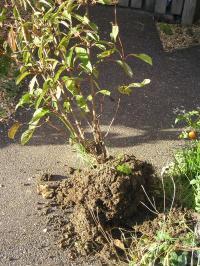How and When to Move Plants in your Garden
 Autumn is a good time of year to relocate plants in your garden
Autumn is a good time of year to relocate plants in your gardenAutumn is probably one of the best times to move plants in your garden if you are unhappy with their current position.
We all make mistakes in life. For the gardener, the mistake might only be as serious as using an unsuitable fertiliser, or pruning a shrub at the wrong time of year.
However, one of the joys of gardening is that if you do make a mistake, it can quite often be easily rectified. Take planting as an example, if you choose the wrong location when planting a new addition to the garden, then autumn is a good time to attempt to move it
Apart from large mature trees and shrubs there are many plants that can be successfully transplanted from one location to another, even if they have rooted and established in a particular position over a number of years.
When to Move Plants
If you want to give it a go, autumn is a good time to move plants. Although most plants are still holding on to their leaves, they will certainly be significantly slowing down and thinking about going to sleep for the winter. It is not necessary to wait for a deciduous plant to drop all itís leaves before moving it.
Moving plants is best done in autumn because water uptake through the roots is minimal due to a slow down in growth rate, this combined with reduced sunlight and shorter, cooler days. The stress and potential root damage to the plant is therefore minimal. The soil is also still relatively warm, encouraging the plant to make some new root growth before the winter in itís cosy new home.
So, if you have previously planted in the wrong place go ahead and have a go at a self-move. If you are not very confident in your own ability or the plant to move is particularly precious, you can always create your own insurance policy by rooting some cuttings from the plant before you attempt to move it
How to Move Plants
Digging Up
Once the cuttings are rooted you can sharpen your surgical spade and begin the transplant. Start by cutting a spade depth circle around the plant; use the current spread of the plant as a guide to the diameter of this circle. Once this is done, you can begin to manoeuvre the spade under the plant and begin undercutting through any root resistance. Some minor root damage is inevitable when you do this that is why you are doing it at this time of year.
The rootball is now complete, a term used to describe the big lump of soil that surrounds the roots now that you have cut all around and under the shrub with your spade. The bigger the rootball the better, but it also very important to think about your back and how much weight you are going to have to lift when you attempt to move the plant and itís rootball to itís new location. If there is help available, use it, the more the merrier, a damp rootball in autumn can be very heavy. If you need to, you can carefully fork away some soil from the rootball to reduce the weight and size
Replanting
The new planting hole at the new location should already have been dug. In an ideal world the rootballed plant wants to be in its new planting hole promptly after the transplant. Fork some well-rotted manure or garden compost into the planting hole therefore providing some food for the plant in the coming months. When moving the plant, use hessian sacking or an old sheet, the idea being to keep the rootball stable and prevent it falling away from the roots during the move.
Carefully lower it into the new hole and slide the hessian or sheet out from under it. Use a cane laid across the planting hole to make sure the plant is to be planted at exactly the same level as before. Planting too deep can cause rotting of stems in wet spells, planting too shallow can result in root exposure to the elements. Firm the soil in the planting hole as you replant.
Job complete, no chance! Make sure you water the transplant thoroughly especially in periods of dry weather during the first few months of re-establishment.
Filed under DIY Gardening Jobs.
